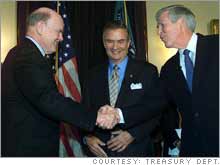 |
| Former Senator (R-Fla.) and tax reform panel chairman Connie Mack (right) shakes hands with Treasury Secretary John Snow. Former Senator (D-La.) John Breaux, vice chairman of the panel, looks on. |
|
|
|
|
|
| Mortgage tax changes: Winners & losers
|
 Here's a look at some issues concerning the tax reform panel's proposal to trim mortgage breaks.(Full story.)
Here's a look at some issues concerning the tax reform panel's proposal to trim mortgage breaks.(Full story.)
|
|
|
|
|
|
NEW YORK (CNN/Money) -
The president's tax-reform advisory panel submitted two final proposals Tuesday morning to the Treasury Department, both of which offer significant changes to the tax breaks people have come to expect -- as well as to the complexity and costs of filing that many have come to detest.
The question of who wins and who loses is always huge when changes to the tax code are proposed. Speaking on Bloomberg TV Tuesday morning, panel chairman Connie Mack, a former senator from Florida, urged taxpayers to "look at the entire package and not pick one portion of it to determine if it's good for them."
The panel's mission was not to reduce taxes, but rather to make the tax code simpler, fairer and better able to promote economic growth. The president also told panel members that any proposal would have to raise the same amount of tax revenue that Uncle Sam collects today.
Upon receiving the panel's report at a press conference Tuesday morning, Treasury Secretary John Snow said the proposals would be a starting point for recommendations the Treasury would make to the president, possibly by year end.
If that's the case, President Bush may include some specific recommendations for tax reform in his State of the Union address early next year. But that doesn't mean changes are imminent. All tax proposals are controversial and some of the panel's proposals have already come under fire.
Here are some of the key changes that are common to both of their proposals:
Eliminate the alternative minimum tax
The AMT is a parallel tax system originally intended to ensure the wealthy pay their fair share of taxes by eliminating many of the deductions and credits available under the regular income tax system.
But because the income-exemption levels have never been indexed to inflation, by 2010 the AMT threatens to catch more than 30 million taxpayers, mostly from middle-income households. The estimated cost of repealing the AMT is $1.3 trillion over 10 years.
The panel was instructed to come up with proposals that are revenue-neutral, meaning they would have to produce the same revenue as expected under the current system.
As a result, the panel had to take a hard look at the tax breaks offered under the current system to see where they could make up for that lost revenue, while at the same time ensuring a new tax code was fairer and more growth oriented than the current one.
(For more on their mandate to make their proposals revenue-neutral, click here.)
Reduce investment taxes
In the panel's first proposal, focused on simplifying the tax code, dividends from domestic earnings would be tax-free as would 75 percent of the capital gains you receive. The other 25 percent of gains would be subject to your marginal (or top) tax rate.
The net effect is that your capital gains would be taxed at rates between 3.75 percent and 8.25 percent, depending on your tax bracket.
Under the existing code, dividends and long-term capital gains are taxed at 15 percent or less, but they are set to go higher after 2008.
Interest on everything except tax-exempt municipal bonds would continue to be taxed at individual rates as is the case in the existing tax code.
In the panel's second proposal, dividends, capital gains and interest would all be taxed at 15 percent.
Alter homeowners' tax breaks
The panel recommended lowering the mortgage-interest cap, which is the amount of a loan on which homeowners would receive a tax break for interest paid, from $1 million to the average regional housing price in the range of $227,000 to $412,000.
The deduction would be converted to a credit equal to 15 percent of interest paid on mortgages up to the interest cap. A credit is a dollar-for-dollar reduction of the taxes you owe, while a deduction only reduces your taxable income by a percentage equal to your top tax rate. Deductions benefit high-income taxpayers the most and are limited to those taxpayers who itemize on the federal tax returns.
Generally speaking, the higher your mortgage loan and the higher your tax bracket, the more likely it is that you'll see less of a tax break than you would under the current system.
(See more on how changes could affect your tax bill.)
Reduce the marriage penalty
All tax brackets, family credits and taxation of Social Security benefits for couples would be double those of individuals.
Under the current system, some two-earner married couples filing jointly end up paying more in taxes than two single taxpayers with the same income.
Reduce tax breaks on employer-provided health insurance
When you work for a company, your employer typically foots a large portion of your health-insurance premiums. That money, which is not reported on your W2, is tax-free to you.
The panel recommended capping the amount of tax-free money that may be used to pay for health insurance to $5,000 for single coverage or $11,500 for family coverage.
Repeal the federal deduction of the state and local tax deductions
Under the proposals, taxpayers would no longer be allowed to deduct the state and local taxes they pay on wage income, investment income and property.
Former Senator John Breaux of Louisiana, who is the panel's vice chair, on CNBC Tuesday morning explained part of the panel's reasoning this way: "If people in California want to pay extra taxes to have their trash picked up, people in Texas shouldn't have to subsidize it."
Reduce the number of tax brackets
Under the panel's first proposal, which is a streamlined version of the current income tax, the number of tax brackets would be reduced from 6 to 4. They would be: 15 percent, 25 percent, 30 percent and 33 percent.
Under their second proposal, which combines the income tax with a progressive consumption tax, there would be only three tax brackets: 15 percent, 25 percent and 30 percent.
Reduce and simplify tax-advantaged savings accounts
You might be forgiven for not being able to keep straight the differences between several types of IRAs, various types of 401(k)s, to say nothing of HSAs, FSAs, Coverdells and 529s.
The tax-reform panel is proposing to consolidate defined-contribution plans -- e.g. 401(k)s, 403(b)s, 457s -- into one Save at Work Account with simple rules and an annual contribution limit of $10,000.
They also propose replacing all types of IRAs with one Save for Retirement Account that would be available to all taxpayers. You could contribute up to $10,000 a year with after-tax dollars that would grow tax-free. Currently, your income and your workplace savings options determine whether you're eligible to contribute to different types of IRAs and whether your contributions can be deductible or whether your earnings grow tax-free.
Education savings plans like 529s and health savings plans like flexible spending accounts (FSAs) would all be consolidated into one Save for Family Account. This account, which would be available to all taxpayers, could also be used for new home and retirement savings as well. You could contribute up to $10,000 a year with after-tax dollars that would grow tax-free.
Simplify tax filing
The panel proposes creating a 1040 Simple form that could fit on both sides of a 4 X 6-inch index card. The number of lines would be reduced from 75 on the current form to 32 on the proposed form. It would also reduce the number of schedules, forms and worksheets from 52 to 10.
The panel also proposes creating two new credits: one for family, which would replace the standard deduction, the personal exemption, the child tax credit and the head of household filing status and tax bracket; and one for work, which would consolidate the earned income tax credit and refundable child tax credit.
See also: Tax-friendly places to live and state-by-state rankings

|